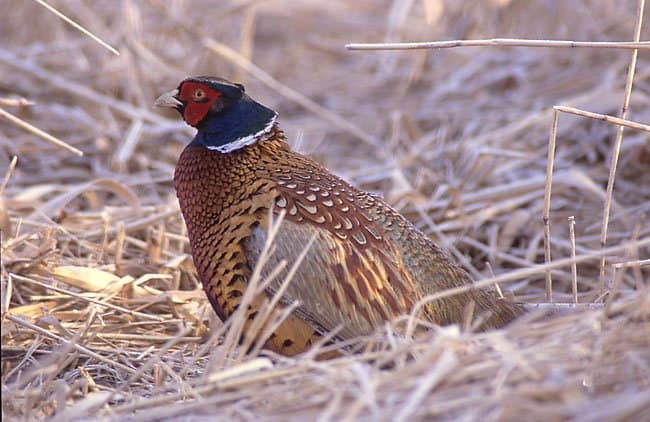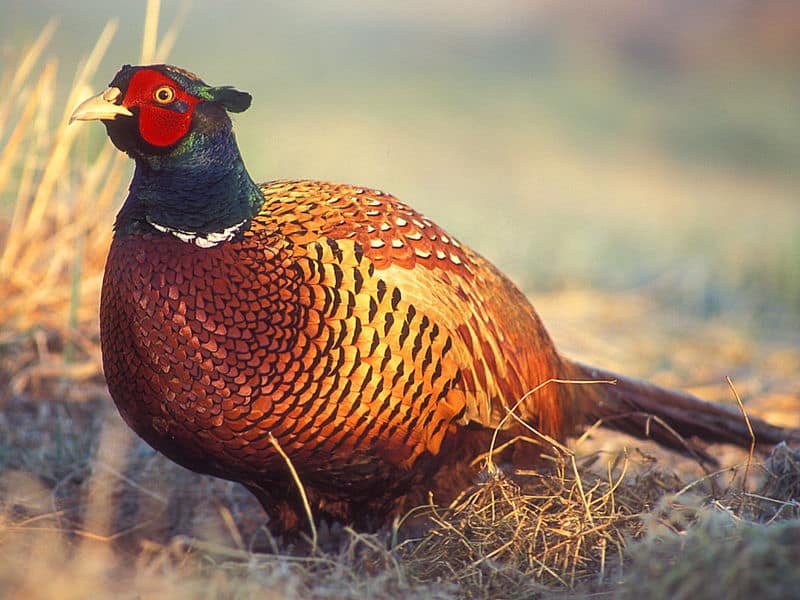The male ring-necked pheasant is a beautiful bird, with unique patterning, and wildly contrasting coloration. Most notable, of course, is the bright white ring surrounding its neck, just below a reflective green with a splash of red around the eyes.
The females are not as beautiful, though they have a distinct advantage that the male ring-necked pheasant lacks. Females are camouflaged blending in well with their preferred environment, tall field grass.
As a game bird, the ring-necked pheasant is taken for granted by most Americans, especially those who prefer to hunt them. However, this particular breed of bird isn’t indigenous to North America. It’s not indigenous to South America either.
The Habitat of a Ring-Necked Pheasant
Ring-necked pheasants are native to Asia, not seeing American shores for the first time until the late 19th century. The tall grasses, especially in low-lying areas, of the plains, agricultural lands, oil fields, and marshes are preferable to these pheasants.
They especially love the kind of low underbrush and grass that effectively conceals them, particularly when nesting. It’s the perfect environment for a nesting female since she blends in far better than her male counterpart.
They won’t remain in one place after the nesting season, however, moving on to alfalfa fields or something similar. People tend to associate ring-necked pheasants with endless, grassy plains and fields that stretch, unbroken, past the horizon. As it turns out, that’s exactly what these birds prefer.
What Does a Ring-Necked Pheasant Eat?

©Marek Szczepanek / CC BY-SA 3.0, from Wikimedia Commons, the free media repository – Original / License
Ring-necked pheasants are omnivorous, consuming most of their daily diet on the ground. Like chickens, they use their talons to scratch at the earth, exposing earthworms, grubs, and other creatures just beneath the upper layer of the soil.
Veggies and fruits are on the menu as well. A ring-necked pheasant will savage a blueberry bush but is just as content with grains, seeds on the ground, various green vegetation, and plant roots.
Spiders, small snakes, small frogs, lizards, salamanders, snails, and even rodents, though the last few are generally few and far between on the pheasant’s list of delicious meals. In short, the typical environment around a ring-necked pheasant is host to a hundred different things the bird likes to eat.
That’s good news for a pheasant, and they rarely find themselves lacking quality consumable resources. Their diets are typically seasonal as well, since fall, winter, and early spring see a conspicuous lack of cold and warm-blooded prey, along with robust vegetation opportunities.
Ring-Necked Pheasant Behavior
Ring-necked pheasant behavior is fairly typical. The males prep for the mating season with several gaudy displays and fiercely compete against rival males who choose to confront them.
While these confrontations are often very violent in appearance, including bouts of aerial combat, they’re rarely fatal for either the dominant male or the challenger.
Males take over entire groups of females, keeping them all together while the females make the male work for it, usually by running away whenever the male tries to boast. The female ring-necked pheasant acts similarly to chickens. They spend a lot of time creating pockets in the ground to roll around in, dusting themselves.
Unlike chickens, ring-necked pheasants lay between 6 and 14 eggs, sitting on them for nearly a month. They create their nests on the ground, using whatever is available around them, including their feathers. There is no established migratory pattern for pheasants, and they simply slow their metabolism throughout the cold months.
Ring-Necked Pheasant Sounds

©Common_Pheasant_Phasianus_Colchicus.jpg: David Croad derivative work: Donkey shot, CC BY 3.0, via Wikimedia Commons – Original / License
Ring-necked pheasants are at their loudest when startled and flushed from cover. They make a unique sound that’s half horn blast and half whistle—difficult to describe in terms that properly relay the noise.
The male is often loudest during mating season, for obvious reasons, but most pheasant calls are alerts for danger (females) and typical male crows, which occur at any time throughout the day, week, month, and year, for any reason.
Most of the time, a female ring-necked pheasant makes small, peeping sounds, which most people take for the sounds of baby chicks. Females are capable of being much louder when on high alert, however. Females also emit a sort of hiss, similar to how most would imagine a snake hisses.
Ring-Necked Pheasant’s Young
While most freshly hatched birds remain in the nest for a while, pheasants are the exception to the rule. Almost as soon as the hatch, ring-necked pheasant chicks are up and out of the nest, following their mother around and sticking close to her side.
They’re also very, very tiny, which makes it even stranger that they leave the nest so quickly. Oftentimes, females will lay their eggs in an already established, prairie chicken nest. This ends up confusing prairie chickens and ring-necked pheasants, both of whom often end up raising each other’s chicks.
Baby pheasant chicks grow up rapidly, often taking flight in just 12 days. Despite that, they typically stay close to their mother for close to three months before they separate and go their own way.
Eggs
The normal number of eggs a pheasant lays is around 10 but not always, sometimes lower and sometimes higher. The female will incubate her eggs for close to a month, sometimes in as few as 23 days.
For the most part, the eggs are smallish and fairly plain, with a tan hue. Sometimes, the female will lay blue eggs too, mostly depending on her diet in the preceding months.
Ring-necked pheasants will sometimes share nests, laying them together in what is known as a clutch. These “clutches” of eggs may be a shared nest between two pheasants or between a pheasant and a prairie chicken.
Conservation Status

.
©Lukasz Lukasik / CC BY-SA 3.0, from Wikimedia Commons, the free media repository – Original / License
Ring-necked pheasants are big-time game birds and most states allow for seasonal hunting, usually with bag limits on the number of ring-necked and other pheasants a hunter can bring home in a single day or throughout the season.
Between the mid-1960s and 2019, the Ring-necked pheasant population decreased by 27%, according to the North American Breeding Bird Survey. However, with a rough estimate of 56 million of them, ring-necked pheasants are far from endangerment.
It’s also not the hunting that’s the driving force of the population decline. Farming equipment and cars are responsible for far more ring-necked pheasant deaths than heavily regulated hunting seasons.
Final Thoughts
The ring-necked pheasant is a stunning bird, even if you allow for the more subtle, camouflaged appearance of the female. Like most birds, they have their own, unique empire amongst the tall grasses, underbrush, and marshes of the world.
They’re excellent game birds, though their numbers are mostly controlled and reduced by inadvertent aspects of civilization, such as farming and driving to work. With well over 50 million of them, they’re on the low end of conservation status. If you spot a ring-necked pheasant, count yourself lucky, as they are very good at hiding and rarely poke their heads out of their own, curious world, to see what else is going on.
The photo featured at the top of this post is © Piotr Krzeslak/Shutterstock.com
Thank you for reading! Have some feedback for us? Contact the AZ Animals editorial team.







